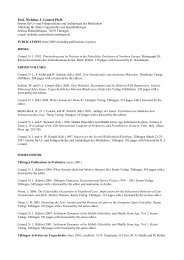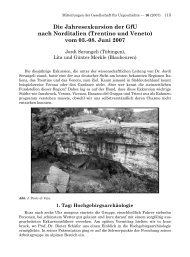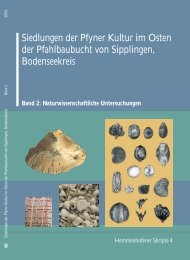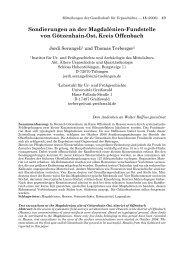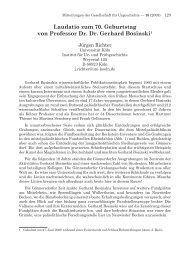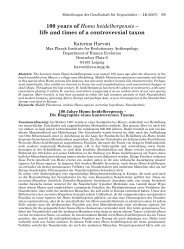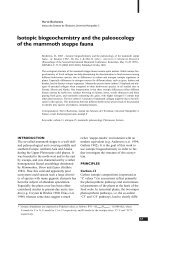bronze age environment and economy in the troad - Universität ...
bronze age environment and economy in the troad - Universität ...
bronze age environment and economy in the troad - Universität ...
You also want an ePaper? Increase the reach of your titles
YUMPU automatically turns print PDFs into web optimized ePapers that Google loves.
chapter 3: analysis<br />
In most of <strong>the</strong> samples, however, typical weeds seem to be <strong>the</strong><br />
dom<strong>in</strong>ant group amongst <strong>the</strong> wild plants.<br />
To summarise <strong>the</strong> proportions of crops, weeds <strong>and</strong> waterplants,<br />
most of <strong>the</strong> samples consisted ma<strong>in</strong>ly of crop species (up to<br />
100% of plant rema<strong>in</strong>s <strong>in</strong> one of <strong>the</strong> flax samples <strong>and</strong> <strong>in</strong> some<br />
of <strong>the</strong> pea deposits, Graph 18, 19b <strong>and</strong> 26) <strong>and</strong> <strong>the</strong> proportion<br />
of plant rema<strong>in</strong>s from crop species is higher than <strong>in</strong> <strong>the</strong> Early<br />
Bronze Age samples. The apparently high percent<strong>age</strong> of weeds<br />
(up to 50%) <strong>in</strong> <strong>the</strong> two flax samples visible <strong>in</strong> <strong>the</strong> diagram, is<br />
due to <strong>the</strong> classification of Camel<strong>in</strong>a sativa as a weed. All <strong>the</strong><br />
o<strong>the</strong>r samples conta<strong>in</strong>ed less than 30% weeds, amongst <strong>the</strong>m<br />
those abundantly associated with flax (Fumaria offic<strong>in</strong>alis)<br />
(Graph 19c). Waterplants generally were a m<strong>in</strong>or component<br />
of samples <strong>and</strong> only <strong>in</strong> three samples were more than 50% of<br />
plant rema<strong>in</strong>s from waterplants.<br />
3.2.4.3 Diversity<br />
Only <strong>in</strong> three cases were pure s<strong>in</strong>gle crops deposited (Graph<br />
27). In general, more than three crop categories are presented<br />
<strong>in</strong> each of <strong>the</strong> samples.<br />
The waterplant group occurs ma<strong>in</strong>ly <strong>in</strong> samples dom<strong>in</strong>ated by<br />
cereal chaff. This was also <strong>the</strong> case for <strong>the</strong> Early Bronze Age<br />
samples.<br />
Generally, samples conta<strong>in</strong>ed not more than 10 typical weed<br />
species, but more typical weeds species were present than <strong>in</strong><br />
<strong>the</strong> previous (Early Bronze Age) period Graph 6 <strong>and</strong> 19c).<br />
Dur<strong>in</strong>g Middle Bronze Age 13 of <strong>the</strong> possible 16 crops were<br />
cultivated, which is more than <strong>in</strong> any o<strong>the</strong>r period. One might<br />
be tempted to speculate about why so many different food<br />
plants were cultivated. Diversified cropp<strong>in</strong>g may occur <strong>in</strong><br />
wealthy as well as <strong>in</strong> poor societies, ei<strong>the</strong>r to enrich <strong>the</strong><br />
everyday kitchen or as a form of protection aga<strong>in</strong>st <strong>the</strong> risk of<br />
crop failures.<br />
Wild species from some habitats occur more frequently than <strong>in</strong><br />
<strong>the</strong> Early Bronze Age. These are <strong>the</strong> weeds, species from open,<br />
relatively dry habitats, from woodl<strong>and</strong> <strong>and</strong> coastal habitats.<br />
The range of species from open, ‛grassl<strong>and</strong>’-type vegetation,<br />
maquis <strong>and</strong> freshwater vegetation is narrower than <strong>in</strong> <strong>the</strong><br />
previous period. Consider<strong>in</strong>g crops <strong>and</strong> weeds only, a lower<br />
degree of specialisation is <strong>in</strong>dicated.<br />
3.2.5 Late Bronze Age Troy<br />
3.2.5.1 General patterns of <strong>the</strong> crop species<br />
With 64 samples <strong>and</strong> 82 species, <strong>the</strong> plots of <strong>the</strong> Late Bronze<br />
Age samples from Troy were very ‛busy’, so that only rough<br />
patterns were visible <strong>in</strong> graphs such as 28.<br />
Look<strong>in</strong>g at <strong>the</strong> sample classes (site classes; Graph 28) <strong>the</strong> first<br />
axis separates some of <strong>the</strong> Troy VIIa samples, which were<br />
dom<strong>in</strong>ated by chickpea, from <strong>the</strong> rema<strong>in</strong><strong>in</strong>g samples. Amongst<br />
o<strong>the</strong>r rema<strong>in</strong>s associated with chickpea were <strong>the</strong> weedy<br />
Lathyrus sativus/cicera, Quercus sp. <strong>and</strong> Thymelaea sp..<br />
Barley was separated from <strong>the</strong> o<strong>the</strong>r crops along <strong>the</strong> second<br />
axis, which was also responsible for <strong>the</strong> group<strong>in</strong>g of hulled<br />
wheat gra<strong>in</strong>, emmer chaff, bitter vetch, grape <strong>and</strong> fig <strong>in</strong> <strong>the</strong><br />
third quadrant, <strong>and</strong> e<strong>in</strong>korn chaff, flax, horse bean, millet,<br />
olive, lentil <strong>and</strong> Triticum aestivum/durum gra<strong>in</strong> <strong>in</strong> <strong>the</strong> fourth<br />
quadrant. Of <strong>the</strong> wild plants, those most associated with barley<br />
are morphologically similar grasses such as weedy barley<br />
types. Most of <strong>the</strong> waterplants were associated with grape, fig<br />
<strong>and</strong> flax, which better reflects <strong>the</strong> processes of deposition than<br />
<strong>the</strong> natural habitats of <strong>the</strong>se species. As <strong>in</strong> <strong>the</strong> samples from<br />
earlier periods, grape <strong>and</strong> fig are <strong>in</strong> most cases closely<br />
associated. This could <strong>in</strong>dicate similar consumption patterns,<br />
or less probably cultivation <strong>in</strong> <strong>the</strong> same plantations, as is<br />
recognised from L<strong>in</strong>ear B tablets (Palmer 1995). As grape was<br />
ubiquitous but never abundant, it is suggested that <strong>the</strong> grape<br />
seeds <strong>in</strong> <strong>the</strong> samples are from grapes which, like figs, were<br />
consumed as fruit, ei<strong>the</strong>r fresh or dried.<br />
Correspondence analysis of <strong>the</strong> same data after <strong>the</strong> exclusion<br />
of Cicer ariet<strong>in</strong>um shows <strong>the</strong> existence of three ma<strong>in</strong> groups<br />
(Graph 29). Most of <strong>the</strong> Troy VIIb samples (group 1) are<br />
separated from <strong>the</strong> o<strong>the</strong>r samples. They conta<strong>in</strong> hulled wheat<br />
chaff <strong>in</strong> abundance, some weeds <strong>and</strong> most of <strong>the</strong> water<strong>in</strong>dicat<strong>in</strong>g<br />
plants. A small group of samples (group 2) from<br />
different periods are separated on <strong>the</strong> third axis from <strong>the</strong> o<strong>the</strong>rs<br />
<strong>and</strong> conta<strong>in</strong> ma<strong>in</strong>ly hulled wheat gra<strong>in</strong>, barley gra<strong>in</strong> <strong>and</strong><br />
rachises, bitter vetch, <strong>and</strong> some weeds. The rema<strong>in</strong><strong>in</strong>g samples<br />
<strong>and</strong> species are more or less regularly distributed with<strong>in</strong> <strong>the</strong><br />
first quadrant <strong>and</strong> conta<strong>in</strong> ma<strong>in</strong>ly grasses <strong>and</strong> <strong>the</strong> crops grape,<br />
lentil <strong>and</strong> olive (group 3). An additional cereal, which is<br />
cultivated <strong>in</strong> large amounts for <strong>the</strong> first time <strong>in</strong> Late Bronze<br />
Age Troy, is Panicum miliaceum (Graph 14). Interest<strong>in</strong>gly,<br />
naked wheat almost disappears from <strong>the</strong> set of crops, after<br />
hav<strong>in</strong>g been already established <strong>in</strong> Middle Bronze Age. So<br />
does flax, which occurs from now on only <strong>in</strong> small numbers,<br />
<strong>and</strong> seems to be replaced aga<strong>in</strong> by olive. Fig also shows a<br />
decrease. The traditional cereals display different patterns.<br />
Barley gra<strong>in</strong> <strong>in</strong>creases, emmer <strong>in</strong>creases <strong>in</strong> gra<strong>in</strong> <strong>and</strong> decreases<br />
<strong>in</strong> chaff rema<strong>in</strong>s, <strong>and</strong> for e<strong>in</strong>korn it is <strong>the</strong> opposite case. For <strong>the</strong><br />
latter crop <strong>the</strong>re is a general decrease from <strong>the</strong> set of crops,<br />
which cont<strong>in</strong>ues <strong>in</strong> <strong>the</strong> Post-Bronze Age samples. Of <strong>the</strong> gra<strong>in</strong><br />
legumes, garden pea disappears completely <strong>and</strong> chickpea<br />
appears for <strong>the</strong> first time (Graph 14). The <strong>in</strong>cidence of lentil<br />
<strong>and</strong> grape is very similar to that <strong>in</strong> <strong>the</strong> Middle Bronze Age.<br />
Consider<strong>in</strong>g <strong>the</strong> number of categories (Graph 6), one<br />
recognises some tendencies <strong>in</strong> terms of <strong>in</strong>crease <strong>and</strong> decrease<br />
of species presence with<strong>in</strong> different eco-groups. Altoge<strong>the</strong>r, <strong>the</strong><br />
Late Bronze Age samples conta<strong>in</strong> a wider range of species than<br />
samples from any previous period, partly because <strong>the</strong>re was a<br />
greater number of samples. An <strong>in</strong>crease <strong>in</strong> <strong>the</strong> number of<br />
species from Middle Bronze Age to Late Bronze Age is found<br />
<strong>in</strong> all eco-groups, except for plants from coastal habitats, which<br />
are also no longer that strongly represented <strong>in</strong> absolute seed<br />
counts as <strong>the</strong>y were <strong>in</strong> Middle Bronze Age. Consider<strong>in</strong>g <strong>the</strong><br />
dist<strong>in</strong>ct differences <strong>in</strong> <strong>the</strong> composition of <strong>the</strong> various ecogroups<br />
between <strong>the</strong> Early Bronze Age <strong>and</strong> <strong>the</strong> Middle Bronze<br />
Age, <strong>the</strong> development <strong>in</strong> <strong>the</strong> Late Bronze Age seems to be just<br />
a cont<strong>in</strong>uation of <strong>the</strong> processes already started <strong>in</strong> Middle<br />
Bronze Age Troy.<br />
43





